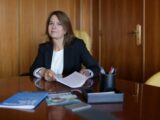Hornet Commissioned First Study From Nielsen To Determine Impact Of LGBTQ-Themed Advertising New study from…

The world’s largest health imaging study launched to create the biggest collection of scans of internal organs
19/04/2016Questo articolo è stato letto 4004 volte!
 The world’s largest health imaging study, funded by the Medical Research Council, Wellcome Trust, and the British Heart Foundation is launched today. It will create the biggest collection of scans of internal organs, and transform the way scientists study a wide range of diseases, including dementia, arthritis, cancer, heart attacks and strokes.
The world’s largest health imaging study, funded by the Medical Research Council, Wellcome Trust, and the British Heart Foundation is launched today. It will create the biggest collection of scans of internal organs, and transform the way scientists study a wide range of diseases, including dementia, arthritis, cancer, heart attacks and strokes.
The £40m study will involve imaging the brain, heart, bones, carotid arteries and abdominal fat of 100,000 current participants of UK Biobank, a visionary project set up in 2006 by the MRC and Wellcome Trust to create a research resource of half a million people across the UK to improve health.
The multi-organ scans will be analysed alongside the vast data already collected from UK Biobank participants. This extra layer of data, for all health scientists to access, will give new perspectives on the best way to prevent and treat multi-faceted conditions like arthritis, coronary heart disease, Alzheimer’s disease and osteoporosis. It will also spark novel ways to analyse and interpret scans, with potential benefits for research as well as for the investigation of patients in the future.
For the last ten years UK Biobank has gathered huge quantities of data on its 500,000 participants – including their lifestyle, weight, height, diet, physical activity and cognitive function, as well as genetic data from blood samples. Linkage to a wide range of health records is also under way, including data from general practices.
Cathie Sudlow, Professor of Neurology and Clinical Epidemiology at the University of Edinburgh, and UK Biobank’s Chief Scientist, said: “This very large number of participants involved in the multimodal imaging study is impressive enough. But what makes it truly transformational is the opportunity to combine the rich imaging data with the wealth of other information already available or being collected from participants, particularly their health and diseases during follow-up for many years to come.”
Dr Sara Marshall, Head of Clinical Research at the Wellcome Trust, said: “Capturing such a vast number of images of the human body, in both health and illness, will chronicle disease in a way never attempted before.
“Each day we’re discovering more and more about how genetics and lifestyle play a part in the onset and development of diseases, but this extra piece of the puzzle – seeing physical changes even before symptoms develop – will give us a completely new perspective on how we can prevent and treat them.”
An initial study of 8,000 participants has just been completed at a purpose-built scanning facility at UK Biobank’s headquarters in Stockport, which is now being used for the main study. The people scanned do not receive any feedback about their health, unless potentially serious abnormalities are spotted during the imaging.
Imaging will include:
- MRI assessment of heart chamber diameter, the volume of blood flow, and how the heart changes as it pumps blood around the body, thickness of the heart wall and the size, shape and stiffness of the thoracic aorta, the vessel that delivers blood from the heart
- MRI measures of brain structure and function, volumes of grey matter and the mapping of major brain connections
- Dual-energy X‑ray absorptiometry measures of bone density, osteoarthritic change at spine, hip and knee, fractures in the spine, and fat distribution throughout the body
- MRI measures of abdominal fat volume including in the liver and pancreas
- Ultrasound assessment of two major arteries, the carotid arteries, that run either side of the neck to the brain
Recruitment will continue in the north west of England, and will roll out to the south (Reading) and the north (Newcastle) over the coming year.
Contact
Eleanor Green Senior Media Officer, Wellcome Trust
+44 (0)20 7611 8491/ 07808 736272
e.green@wellcome.ac.uk
About the Wellcome Trust
The Wellcome Trust is a global charitable foundation dedicated to improving health. We support bright minds in science, the humanities and the social sciences, as well as education, public engagement and the application of research to medicine.
Our investment portfolio gives us the independence to support such transformative work as the sequencing and understanding of the human genome, research that established front-line drugs for malaria, and Wellcome Collection, our free venue for the incurably curious that explores medicine, life and art.
About the British Heart Foundation (BHF)
Coronary heart disease is the UK’s single biggest killer. For over 50 years we’ve pioneered research that’s transformed the lives of people living with heart and circulatory conditions. Our work has been central to the discoveries of vital treatments that are changing the fight against heart disease. But so many people still need our help. From babies born with life-threatening heart problems to the many Mums, Dads and Grandparents who survive a heart attack and endure the daily battles of heart failure. Join our fight for every heartbeat in the UK. Every pound raised, minute of your time and donation to our shops will help make a difference to people’s lives.
For more information visit bhf.org.uk
About the UK Biobank Imaging Expert Working Group
UK Biobank has a number of expert working groups which were established to help improve the resource. The imaging group members are:
- Chair: Professor Paul Matthews (Imperial College London)
- Associate Professor Naomi Allen (University of Oxford/UK Biobank)
- Professor Jimmy Bell (University of Westminster London)
- Professor Andrew Blamire (Newcastle University)
- Professor Sir Rory Collins (University of Oxford/UK Biobank)
- Mr Steve Garratt (UK Biobank)
- Dr Tony Goldstone (Imperial College London)
- Professor Nicholas Harvey (University of Southampton)
- Professor Alan Jackson (University of Manchester)
- Professor Paul Leeson (University of Oxford)
- Professor Karla Miller (University of Oxford)
- Professor Stefan Neubauer (University of Oxford)
- Dr Tim Peakman (UK Biobank)
- Professor Steffen Petersen (Barts Heart Centre & Queen Mary University of London)
- Professor Stephen Smith (University of Oxford)
- Professor Cathie Sudlow (University of Edinburgh/UK Biobank)
- Secretariat: Ms Nicola Doherty (UK Biobank)
Related Images:

La Redazione delle testate Punto a Capo è composta da volontari che collaborano ad un progetto di condivisione delle informazioni indipendente. La maggior parte dei collaboratori sono pubblicisti, giornalisti, addetti stampa, ma ci sono anche collaboratori alle prime armi che iniziano ad approcciarsi al mestiere in un ambiente libero e senza padroni, il cui principio è dal lontano 1989 di essere la voce di chi voce non ha.

